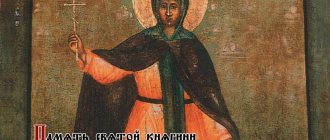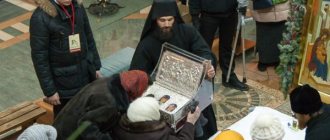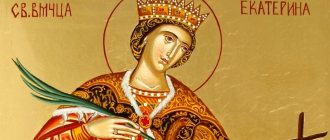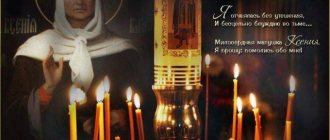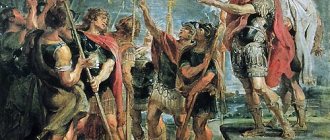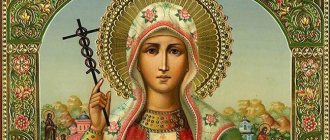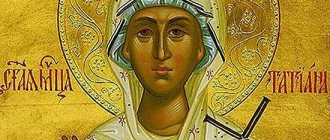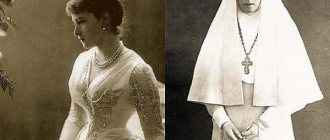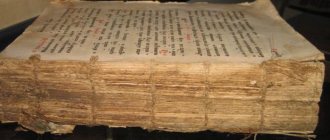The holy martyr is highly revered among Orthodox believers, her name is written in church calendars, and in churches people can see images with her face. A large number of pilgrims from Russia and abroad come to one of the Moscow cathedrals to venerate the remains of St. Lyudmila and receive a divine blessing along with intercession.
The icon of the holy mother patronizes all Lyudmilas, as well as grandmothers, beloved mothers, and teaching staff.
Icon of the Holy Martyr Lyudmila
Basic facts of the princess's biography
In an ancient document from the 11th century, Princess Lyudmila is compared to the morning star, who with the light of faith dispelled the darkness of error. Her name is one of the most beloved not only among us, but also among other Slavic peoples. The biography of Saint Lyudmila of Czech has many facts in common with the patroness of the Russian land, Saint Equal-to-the-Apostles Princess Olga. These great women became widows early, helped their children run the state, and raised their grandchildren. While in adulthood, Lyudmila and Olga became Orthodox Christians, setting an example for their subjects, and after their death they were canonized.
The veneration of the martyr Lyudmila of Czechia in Rus' began during the reign of Equal-to-the-Apostles Prince Vladimir and his descendants and continues to this day.
Origin and childhood
According to historical documents, Saint Lyudmila was born in 860 in Serbia, in the family of Prince Slavibor of Pshov. She received a good education and spoke several languages. Accurate information about the princess’s childhood has not been preserved. Her biography became known from two collections - the Russian “Prologue” and an older Latin arrangement composed in the Czech Republic.
Marriage and life in the Czech Republic
Saint Lyudmila, being a very young virgin, was in marriage to the Czech prince Borzhivoj (Borivoj). This marriage pursued political alliances - the unification of disparate tribes of the Western Slavs. Having moved to a country that was distant at that time, the young princess immediately accepted and fell in love with her new homeland.
Then the Czech Republic (present-day Bohemia) was part of a powerful state - Great Moravia under the control of Prince Svyatopolk I. The husband of Lyudmila Borzhiva was his faithful vassal and more than once assisted in battles with King Ludwig II of Germany. For this, the ruler of Moravia gave the Czech prince the lands on which Prague was founded.
Embassy to Byzantium
The heads of the Slavic states sought unification and needed spiritual patronage in order to gain independence from Latin Germany. Only such a great power as Byzantium could help with this. The ruler of Moravia, Prince Rostislav (uncle of Svyatopolk I), sent envoys to her emperor Michael III asking for help. The Byzantine ruler sent Orthodox teachers to Moravia - Saints Cyril and Methodius. It is in this state that their educational mission begins.
Spreading the True Faith
The couple were pagans, like the majority of the population of Bohemia (Czech Republic). Their acquaintance with Equal-to-the-Apostles Methodius led them to the Orthodox faith. During their visit to Great Moravia, they heard a sermon by the saint, who was then Archbishop of Moravia. His words made a great impression on the young couple.
At the court of Prince Svyatopolk I, the ruler of Moravia, Lyudmila and Borzhiva converted to Christianity. The baptismal ceremony was performed by Methodius himself, one of the great Slavic educators. By order of the pious princely couple, the first Orthodox church was erected in the country, consecrated in honor of St. Clement.
Having returned to the Czech Republic, the young couple, who converted to Orthodoxy, began to introduce their people to the Christian faith. Churches were built everywhere, services were held, for which the princes invited priests from Orthodox Bulgaria. They also performed baptism ceremonies for Czech subjects.
During the reign of Lyudmila and Borzhivoj, the second Orthodox church in the Czech Republic was erected in honor of the Blessed Virgin Mary.
Pagan Resistance
Representatives of the Czech aristocracy were dissatisfied with the prince's Christian activities. Their views were shared by the pagan priests - Borzhivoy ordered the destruction of temples and prohibited rituals. Noble Czechs, with the support of troops, rebelled against their ruler. The prince and his family were forced to leave their homeland and took refuge in Moravia. With the help of Svyatopolk I, the rebellion was suppressed. In honor of this event, the ruler of the Czech Republic erected the Church of the Holy Virgin Mary. It was built in the capital at the meeting place of the people's assembly.
Rule and defense of religion after the death of her husband
Two sons were born into the princely family. Their parents raised them as believers and pious people. After fifteen years of marriage, Prince Borzhivoy died, and Lyudmila was left a widow at 29 years old. His eldest son Spitignev became the ruler of the Czech Republic. He died in 915 and the youngest son of the princely couple, Vratislav, ascended the throne.
Saint Lyudmila honestly guarded her widowhood, grieving with dignity and Christian humility for her beloved husband. She went down in history as a wise and kind ruler. The princess managed to maintain diplomatic relations with Svyatopolk I. She fought with all her might for the preservation of Orthodox worship in churches and temples in the Czech Republic. She was in power for a long time until her son Vratislav came of age. The Dowager Princess led a pious life and continued her husband’s work in spreading Christianity among the Czech people.
Raising a successor
The wife of Prince Vratislav was Dragomira, a pagan Christian. The girl was very proud and had an obnoxious character. In this marriage two boys were born - Vaclav (Vyacheslav) and Boleslav. Vratislav did not share the views of his wife and entrusted his main heir to his pious mother. He died when his eldest son was eight years old. The young Prince Vyacheslav had to ascend the Czech throne, but his mother Dragomira began to rule the state as regent.
The upbringing and education of Vyacheslav was entrusted to Princess Lyudmila by his father Vratislav. Under the supervision of his pious grandmother, the boy grew up in the Orthodox faith. They learned foreign languages and translated the Holy Scriptures together. The prince's youngest son was raised by a pagan mother.
Having received power, Dragomira began to restore pagan orders. New temples were built, the priests regained their former influence, the people, who began to live according to the laws of Christianity, were encouraged to participate in pagan rituals. Due to his youth, Prince Vyacheslav could not influence the actions of the wicked mother and protect Czech Christians from persecution. Saint Lyudmila watched with pain in her soul how the Orthodox faith was oppressed. Her attempts to reason with the wicked Dragomira failed. The princess left the capital and continued her charity work in Tetin, where she fervently prayed for Czech Christians.
Death and canonization
Lyudmila's departure did not calm Dragomira. Her hatred of her pious mother-in-law pushed her to commit a crime. The pagan sent assassins to the saint, who entered her chamber in the dead of night. The princess was in her home chapel when two wicked men burst into her chambers.
Saint Lyudmila was strangled by her own veil (povoy), torn from her head. She asked to die by the sword, so that the blood she shed would become a martyr's crown in the name of Christ. But the killers, following Dragomira’s instructions, tried to prevent this and killed the princess with her veil.
This povoy became her symbol, with which the saint is depicted on icons.
The deceased Lyudmila was buried near the city wall. By order of Dragomira, Christian customs were not observed during the princess's funeral. But the Lord did not abandon his righteous martyr and marked the place where she was buried with miraculous healings and apparitions. Grandson Vyacheslav learned about the signs at his grandmother’s grave. He decided to rebury her in the capital, where she rested in the Basilica of St. George. The prince himself continued the work of his pious grandmother. He removed the pagan Dragomira from the court and began to resume Orthodox services in his principality. Saint Ludmila of Bohemia was canonized in the middle of the 12th century with the rank of martyr.
The young wife of Prince Borzhivoj I
According to this source, Saint Lyudmila came from the family of Prince Slavibor, who ruled the Pshovan people in the second half of the 9th century, which most historians identify with the Serbs. Nothing is known about the early years of her life, but it is generally accepted that the young princess was raised in the traditions of paganism, which at that time was the only religion known to her people.
Having reached the right age, she became the wife of another sovereign prince, Borzhivoj I, who became the founder of the ruling Přemyslid dynasty. This marriage, concluded for political reasons, marked the beginning of the process of uniting many tribes then living on the territory of Bohemia, and forming a single nation on their basis.
Iconography
At the end of the 12th and beginning of the 13th centuries, Bishop Daniel II gave his blessing to paint the image of St. Martyr Lyudmila. On the icons the princess is depicted in full height. She is wearing a long dress, and her head is covered with a povoy (veil) or a princely hat. The povoy (or rope) descends around the saint’s neck and serves as a symbol of her martyrdom.
There is an icon where Lyudmila is depicted with a bowl of grapes in her hands. This is a rather rare image of the Heavenly Martyr. On some icons, the mother princess is represented together with her grandson Vyacheslav. He is next to the pious grandmother and listens carefully to the words of the Holy Scripture. Icons are very common where Saint Lyudmila is depicted with an Orthodox cross in her right hand and a scroll in her left.
Heavenly punishment
The relics of the great martyr are associated with memories of one very mysterious incident, which involuntarily suggests the idea of miracles. Its description is still contained in documents in the Prague archive. The fact is that after the fire that engulfed the Basilica of St. George in the 12th century, the German architect invited to restore it committed a terrible sacrilege: he stole part of the relics of St. Lyudmila and, having transported them to Germany, secretly sold them.
However, after the crime, punishment was not slow to follow. He himself soon died, contracting the plague, and after him, all the buyers of the stolen relics departed to another world. Someone broke his neck by falling from a horse, someone quarreled with a neighbor and was killed, and one respectable 70-year-old baron, who married a very young marquise, gave up the ghost on his first wedding night. Undoubtedly, a curse was hanging over these people, and in order to interrupt the series of deaths, their relatives hastened to return the stolen shrines to the Prague basilica and bring due repentance.
Holidays
Now the name Lyudmila is very common among Russian women. This saint is the first Christian martyr on Czech soil. Her intercession helps protect women from family problems, she patronizes educators and teachers, spiritually strengthens grandmothers and mothers..
Day of Remembrance
The Orthodox Church celebrates the day of memory of St. mts. Lyudmila Czech September 29 (new style). Many women attend the festive service to pray to the Heavenly Patroness.
Day Angel
At the end of September, all Orthodox Christians in Lyudmila celebrate their name day. They receive congratulations on Angel's Day and pray in front of the icon of their Heavenly Protectress.
The first Christian rulers of the Czech Republic
From historical documents that have survived to this day, it is clear that initially the possessions of Prince Borzivoj were limited to only a small territory surrounding his castle, but having taken part in the war of the influential Moravian ruler Svatopluk against the Eastern Franks, he received from him very vast lands as a reward, on which Over time, the capital of the Czech state, Prague, was built.
On icons, it is customary to depict Lyudmila of Czech alone, without her husband, as if he had dissolved in the shadow of her holiness. However, if you believe Latin sources, Prince Borzhivoy I accepted Christianity earlier than she did, and even before marriage he became the spiritual mentor of his future wife. It was thanks to him that she was able to fully experience the greatness of true faith and place it in her heart. If such a statement raises doubts among some researchers, they all agree that it was Borzhivoy and Lyudmila who were the first Christian rulers of the then nascent Czech state.
Where are the relics of the great martyr located?
The Orthodox martyr has been resting for more than a thousand years in the Church of St. George the Victorious, where her grandson Prince Vyacheslav transferred the relics of his great grandmother.
Prague
This temple is located in Prague and was originally Orthodox. But half a century later it passes to the Catholic Church, and later becomes a museum. The relics of the first Slavic patroness are now a museum exhibit and are under the protection of the Czech state. They are not available for worship. You can venerate them only once a year – on September 29th. Pilgrims from all over the world come here with the hope of receiving help from the holy relics.
The head of the princess is separated from the rest of the relics and transferred to the Cathedral of the Czech Catholics, St. Vitus. She wears a gold alloy helmet mask that covers her entire face. She is put up for worship on the day of veneration - September 29.
Particles in Russia
There is an opportunity to honor the memory of the first Heavenly patroness of the Slavs in Russia in the St. Nicholas Church in Kotelniki. There is a reliquary containing a particle of the relics of the righteous martyr.
Another prayer to St. mts. You can visit Lyudmila at the Holy Trinity Lavra. There, in the Church of St. John Climacus, there is her icon with part of her relics.
Sons of the princely couple
The couple had four daughters and two male children. All offspring were raised in the fear of God. The prince passed away at the age of 39, leaving his twenty-nine-year-old wife in widow's grief. The eldest son, Spitignev, also died early, and the youngest, Bratislava, took the throne, but the state was actually ruled by his mother, who was considered a wise ruler. Saint Lyudmila led a righteous life in the Christian faith, helping all those in need, the sick and disadvantaged.
Despite all the efforts of the princess, paganism persisted on the territory of the state, especially among the Polabian Slavs who inhabited the neighboring lands. The affairs of German Romanism not only did not contribute to the rapprochement of local peoples with Christianity, but, on the contrary, became a strong fuel for hostility against it. Bratislava's wife, Dragomira, was a pagan, which, according to some sources, seems very doubtful. It is unlikely that in such a Christian family as the prince’s, the prince’s wife was unbaptized. However, legends claim that she was not a true believer, she was distinguished by arrogance and pride, and due to such character traits and inflexibility, she valued everything Slavic, including paganism. The hatred of faith, brought up in the Polabian Slavs, not without the efforts of the German rulers and missionaries, was also manifested in her.
What do they ask the holy martyr for?
Saint Lyudmila provides intercession to all women with this name. All her earthly life she was a loving wife and mother, a kind and wise grandmother, a zealous keeper of the Orthodox faith. People turn to her with requests in many difficult situations.
Parenting
The holy righteous woman helps in instructing so that the younger generation grows up in the Orthodox religion and follows the Christian commandments.
Choosing a life path
The righteous princess changed her life by converting to Orthodoxy with her husband, and followed this choice all her life. Her faith was steadfast and unshakable. Prayer to Saint Lyudmila will help protect yourself from sin.
Reconciliation
The heavenly patroness of the Czech land always sought to maintain peace in her family. They pray to her for the reconciliation of relatives and the preservation of well-being.
Help with discord and troubles
The righteous princess made a lot of efforts to unite the Czech peoples, tried to peacefully resolve all conflicts and reconcile those at war.
Bereavement relief
Saint Lyudmila experienced many losses of her loved ones during her life. She buried her husband and sons. The Orthodox faith helped her survive this grief. The princess accepted all trials with humility. Prayer before the icon of the martyr will help ease the pain of loss.
The life of this Czech saint serves as an example of Christian service and firmness of faith for all Orthodox Christians.
The morning star that sanctified the Czech Republic
The article provides the text of the most common prayer to the holy martyr Lyudmila of Bohemia. The first part, called the troparion, says that, leaving the darkness of idolatry and absorbing the light of true faith, she, like the morning star, sanctified the Czech land with her worship.
Its continuation, called kontakion, contains a petition for prayers before God for all the faithful (believers) who have found spiritual “wholeness” in her “all-honorable” temple, that is, integrity and completeness. In this text, the word “temple” should not be understood in its narrow meaning, since the compilers of the prayer used it in a figurative sense, meaning the inflexibility of faith, adherence to which can give a person spiritual harmony. The meaning of the icon of Lyudmila of Bohemia, as well as the prayers addressed to her, is unusually deep and can influence a person’s inner world in the most beneficial way.
Texts in Russian
In the Russian Orthodox Church, a prayer, akathist, kontakion, troparion and magnification have been compiled in honor of Saint Lyudmila of Czechia.
Troparion
Having left the darkness of idolatry and with ardent love accepting the light of the Orthodox faith of Christ, you, Saint Lyudmila, appeared like the morning star, and with the light of your holiness began the true day of worship of God in the Honors of the earth.
Kontakion
Chosen by God from the heterodox pagan family of the Czech Republic, called into the holy language, a servant of new grace, the holy, all-praised martyr of Christ Lyudmila, in Thy suffering she received the crown of martyrdom from the hand of the Almighty, imperishable, and with the Angels now standing before His throne, we praise Thee with love, the Servant of Christ, with songs of love. , even with Your prayers free us from eternal torment, troubles and sorrows, calling: Rejoice, blessed Princess Lyudmila, holy martyr and prayer book for souls.
Prayer
Oh, Holy Saint of Christ, martyr Princess Lyudmila, First Lady of the Czech country and the capital city of Prague, an adornment, warm prayer book for us before God, behold, we, who have committed many sins, humbly fall down and pray to you, do not allow us to perish in the mud of our sins, but lift up us prayer.
Oh, Most Blessed Mother Lyudmila, do not forget to visit your children, even if you passed away from us to the heavenly abodes. Together with the Holy Martyr and your grandson Vyacheslav, when the youth Vyacheslav grows up, his father, your son, according to the custom of that time, ask the Bishop and the priests with all the clergy to call upon him the blessing of God. The bishop, having served in the Church of the Most Holy Theotokos, placed the youth on the steps of the temple, and blessed him as follows: “Lord God Jesus Christ, bless this youth, as you blessed your righteous ones, Abraham, Isaac and Jacob, and crown him, as you crowned Orthodox kings, equal to the apostles Constantine and Helen."
In the same way, you, his holy foremother, ask us, sinners, for God’s blessing on our children, and on all of us, even we who have sinned greatly, let us thank the Lord for the gift of His grace. May we together glorify the Father and the Son and the Holy Spirit and your great intercession for us forever and ever. Amen.
Akathist
God-enlightened reason was given to you, holy martyr Lyudmila, with which you clearly understood the soul-destroying futility of your daughter-in-law’s evil faith, who wants to destroy you. You, knowing this, retired to the city of Techin to seek refuge for salvation for the sake of your soul, and you tried to seek Christ with all your soul. In the same way we cry to you: Rejoice, blessed follower of Christ; Rejoice, sincere lover of His commandments. Rejoice, thou who has known the almighty power of Christ’s grace; Rejoice, you who escaped the cruel demonic slavery. Rejoice, you who have considered earthly wealth as nothing; Rejoice, you who despised idolatry from your youth. Rejoice, you who through the hands of the wretched have sent your treasures to grief; Rejoice, you who have called idolatrous people to the true God. Rejoice, blessed Princess Lyudmila, holy martyr and prayer book.
Greatness
We magnify you, passion-bearer of Christ Lyudmila, and honor your honest suffering, which you endured for Christ.
Temples in Prague
The Catholic Church of St. Lyudmila the Martyr was founded in 1888. It is located on Mira Square, in the city district of Vinohrady. This magnificent neo-Gothic building is distinguished by two tall, absolutely identical bell towers. The temple was built in such a way that it seems to float above the square. The height of the towers with a spire is sixty meters. The Church of St. Lyudmila is the dominant feature of the adjacent space and attracts not only worshipers, but also tourists.
A high flight of stairs leads to the main entrance; the heavy doors and portal are decorated with strict ornaments. There are stone porticos on both sides of the entrance, and a large rose window above the portal. Due to the pointed elongated windows, the appearance of the towers seems elongated vertically. The tympanum is decorated with relief images of Christ and saints Wenceslas and Lyudmila.
The Church of St. Lyudmila is active and is the property of the Roman Church. Christians who have accepted the Catholic faith, along with the Orthodox, celebrate the day of the pious Lyudmila and honor her. The sanctuary is open to all believers during services.
Another, no less famous temple was erected in the town of Tetin, near Karlstejn Castle. According to legend, it was erected on the spot where the princess was killed. Under the main altar there is a stone on which - again, according to legend - the saint was praying when the stranglers crept up on her.
The Church of the Martyr, but already belonging to the Russian Orthodox Church, was consecrated in Prague at the end of 2012. It was erected in the former exhibition pavilion of the Rostorgpredstva on Siberian Square. During Soviet times, construction and agricultural equipment was exhibited here, and at a later time there was an exhibition of retro cars. Not long ago, the territory was returned to the fold of the Orthodox Church.
As part of the first stage of reconstruction work, the arrangement of the church was carried out within the main circular volume of the structure. The second stage involves the construction of a bell tower and domes. However, the Orthodox Church of St. Ludmila in Prague is already receiving parishioners who want to offer prayer to the saint. And also those who count on her heavenly help.
